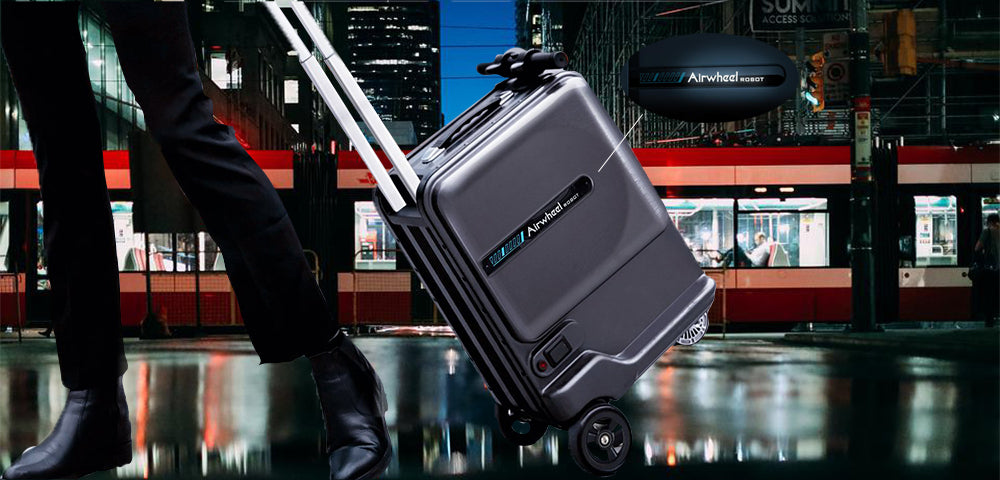What Is Carry-On Luggage?
Carry-on luggage is the small bag or suitcase you’re allowed to bring with you into the airplane cabin. Unlike checked baggage, it stays with you throughout the flight, usually stored in the overhead bin or under the seat in front of you. Knowing the size and weight rules for carry-ons is important — if your bag doesn’t fit, you may be forced to check it at the gate and pay extra fees.
Standard Carry-On Dimensions
Most airlines set limits for both the size and the weight of carry-on luggage, but the rules are not universal. The key difference comes down to whether you’re flying on a domestic U.S. route or with an international airline.
Domestic Carry-On Size
For most major U.S. airlines, the standard maximum carry-on size is 22 x 14 x 9 inches (56 x 36 x 23 cm).
- These measurements include handles and wheels.
- Bags are typically placed in a sizer at the gate to check compliance.
- Southwest is a slight exception, allowing 24 x 16 x 10 inches, giving travelers a bit more space.
International Carry-On Size
International airlines are usually stricter with size rules. A common standard is around 21.5 x 15.5 x 9 inches (55 x 40 x 23 cm).
- European and Asian carriers often require smaller bags compared to U.S. airlines.
- Some budget airlines reduce the allowance further, so double-check before your trip.
Carry-On Weight Limits
Unlike size, U.S. airlines rarely enforce a weight limit for carry-ons — as long as you can lift it into the overhead bin, you’re usually fine. International airlines, however, often set strict limits ranging from 15 to 22 lbs (7–10 kg). For example:
- Singapore Airlines allows up to 7 kg (15 lbs).
- Lufthansa allows up to 8 kg (17 lbs).
- Some airlines also permit an extra laptop bag or handbag in addition to your carry-on.

What Counts as a Personal Item?
A personal item is a small bag that you’re allowed to bring on board in addition to your carry-on luggage. Unlike your carry-on, this bag is usually stored under the seat in front of you, not in the overhead bin. Personal items are meant for essentials you want easy access to during your flight, like electronics, travel documents, or a change of clothes.
Common Examples of Personal Items
- Laptop bags or backpacks
- Handbags or tote bags
- Small duffel bags or crossbody bags
- Camera bags or diaper bags
Size Guidelines
Most airlines allow personal items that fit under the seat, typically around 18 x 14 x 8 inches (45 x 35 x 20 cm).
- The exact size can vary slightly by airline, so it’s a good idea to check before your trip.
- Even if your bag looks small, make sure it can comfortably slide under the seat — some bags may appear compact but have stiff frames or protruding pockets.
Why It Matters
Carrying the right personal item can make your flight more comfortable:
- Keep your essentials within reach without opening your carry-on.
- Avoid gate-checking a bag because it’s too large.
- Stay organized, especially on longer trips or when connecting flights.
Carry-On vs Personal Item: Key Differences
Understanding the difference between a carry-on and a personal item can save you from stress at the airport and help you pack efficiently. While both are allowed in the cabin, they serve different purposes and have different size limits.
Size and Storage
- Carry-On Luggage: Larger and usually stored in the overhead bin. Standard size is around 22 x 14 x 9 inches (56 x 36 x 23 cm) for domestic flights.
- Personal Item: Smaller and fits under the seat in front of you, typically around 18 x 14 x 8 inches (45 x 35 x 20 cm).
Purpose and Content
- Carry-On Luggage: Meant for clothes, shoes, and other items you need during your trip but don’t require immediate access to during the flight.
- Personal Item: Designed for essentials you need on board, like laptops, tablets, passports, snacks, or medications.
Airline Rules
- Most airlines allow one carry-on and one personal item per passenger.
- Exceeding the size or quantity limit can result in additional fees or gate-checking.
Packing Tips
- Use your personal item for valuables and items you want easy access to.
- Keep the carry-on for bulkier items that you don’t need until you reach your destination.

What Is Ride-On Carry-On Luggage?
Ride-on carry-on luggage is a modern travel solution that combines a traditional carry-on suitcase with a built-in rideable platform. It allows travelers to move quickly through airports while keeping their belongings close at hand, making it especially convenient for large terminals or tight layovers.
Size and Weight Considerations
Travelers who want to zip through airports on a motorized suitcase still need to make sure their bag meets airline carry-on requirements. Paying attention to both size and weight is essential to avoid gate-checking or denied boarding. The main considerations include:
- Maximum Dimensions: Most ride-on carry-on bags are around 22 x 14 x 9 inches (56 x 36 x 23 cm) to fit in the overhead bins. Some models designed for international flights may be slightly smaller to meet stricter airline requirements.
- Weight Limits: These bags generally weigh between 7 and 10 kilograms (15–22 lbs) when empty, keeping them within typical airline carry-on weight allowances.
- Practical Considerations: Even if the bag meets size and weight limits, travelers should consider the ease of lifting it into the overhead bin, as some models are heavier due to motors and batteries.
Airline Regulations for Batteries and Motors
Most airlines have clear rules regarding ride-on carry-on luggage because of the lithium-ion batteries they contain. To travel safely and comply with airline policies, passengers need to follow these common regulations:
- Lithium-ion batteries must not exceed 100 watt-hours (Wh) per battery.
- Batteries must be installed securely inside the luggage; loose or improperly secured batteries are generally not allowed.
- Spare batteries must be removable and carried in the cabin, not in checked luggage.
- The total number of batteries carried may be limited depending on airline policy.
- Luggage with built-in motors must comply with carry-on size and weight limits set by the airline.
These rules are based on standard airline and international safety regulations for lithium-ion batteries in carry-on luggage. Following them helps ensure your ride-on luggage is accepted at the gate without issues.
Popular Ride-On Luggage Brands
There are several ride-on carry-on luggage models on the market that combine portability, convenience, and technology. These suitcases are designed to meet airline carry-on requirements while allowing travelers to ride through airports instead of walking. Some of the most popular models include:
- Motorised Suitcase® MS1: A more advanced ride-on suitcase featuring a smart LED display that shows both riding speed and battery level, combining carry-on compliance with a high-tech, rideable design.
- Airwheel SE3L: Lightweight and foldable design, easy to maneuver through airports while meeting carry-on regulations.
- Aotos L2: Compact ride-on luggage with a reliable motor system, designed to stay within airline size and weight limits.

How to Measure Your Carry-On Correctly?
Measuring your carry-on luggage accurately is essential to avoid surprises at the airport. Even if your bag looks small, airlines are strict about both size and weight limits, and a single inch can make the difference between keeping your bag in the cabin or being forced to check it. Here’s how to measure your carry-on correctly:
Step 1: Measure Height
Place your bag upright and measure from the bottom of the wheels to the top of the extended handle. This ensures you account for the tallest point of your luggage.
Step 2: Measure Width
Measure from one side of the suitcase to the other at its widest point. Be sure to include any protruding handles or side pockets.
Step 3: Measure Depth
Measure from the front of the suitcase to the back. Again, include any external pockets or protrusions that could add to the total depth.
Step 4: Calculate Linear Inches
Most airlines calculate size using linear inches, which is the sum of height, width, and depth. For example, a bag that is 22 x 14 x 9 inches has a total of 45 linear inches. Always check your airline’s specific limit.
Step 5: Weigh Your Bag
Once measured, place your packed bag on a scale. Many airlines enforce weight limits in addition to size, so knowing your bag’s weight helps prevent gate-checking or extra fees.
Step 6: Double-Check After Packing
Luggage can expand slightly after packing. Always re-measure your bag once it’s fully packed to make sure it still fits within the airline’s limits.
By following these steps, you can confidently ensure your carry-on meets airline requirements and avoid stress at the gate.
What Are the Carry-On Size Rules by Airline?
U.S. Domestic Airlines
| Airline | Carry-On Size | Carry-On Weight | Personal Item Size |
| American Airlines | 22 × 14 × 9 in (56 × 36 × 23 cm) | No official limit | 18 × 14 × 8 in (45 × 35 × 20 cm) |
| Allegiant Air | 22 × 14 × 9 in (56 × 36 × 23 cm) | No official limit | 16 × 15 × 7 in (40 × 38 × 18 cm) |
| Alaska Airlines | 22 × 14 × 9 in (56 × 36 × 23 cm) | No official limit | 17 × 13 × 9 in (43 × 33 × 23 cm) |
| Breeze Airways | 22 × 14 × 9 in (56 × 36 × 23 cm) | No official limit | 17 × 13 × 8 in (43 × 33 × 20 cm) |
| Delta Air Lines | 22 × 14 × 9 in (56 × 36 × 23 cm) | No official limit | Must fit under seat (no size listed) |
| Frontier Airlines | 24 × 16 × 10 in (61 × 41 × 25 cm) | No official limit | 18 × 14 × 8 in (45 × 35 × 20 cm) |
| Hawaiian Airlines | 22 × 14 × 9 in (56 × 36 × 23 cm) | Up to 25 lb (11 kg) | 16 × 10 × 9.5 in (40 × 25 × 24 cm) |
| JetBlue Airways | 22 × 14 × 9 in (56 × 36 × 23 cm) | No official limit | 17 × 13 × 8 in (43 × 33 × 20 cm) |
| Southwest Airlines | 24 × 16 × 10 in (61 × 41 × 25 cm) | No official limit | 16.25 × 13.5 × 8 in (41 × 34 × 20 cm) |
| Spirit Airlines | 22 × 18 × 10 in (56 × 46 × 25 cm) | No official limit | 18 × 14 × 8 in (45 × 35 × 20 cm) |
| United Airlines | 22 × 14 × 9 in (56 × 36 × 23 cm) | No official limit | 17 × 10 × 9 in (43 × 25 × 22 cm) |
International Airlines
Major Asian Airlines
| Airline | Carry-On Size | Carry-On Weight | Personal Item Size |
| Emirates | 22 × 15 × 8 in (55 × 38 × 20 cm) | Up to 7 kg (15 lb) | Must fit under seat (no fixed size) |
| Qatar Airways | 20 × 15 × 10 in (50 × 37 × 25 cm) | Up to 7 kg (15 lb) | Must fit under seat (no fixed size) |
| Singapore Airlines | Sum of L+W+H ≤ 115 cm (45 in) | Up to 7 kg (15 lb) | 16 × 12 × 4 in (40 × 30 × 10 cm) |
| All Nippon Airways (ANA) | 22 × 16 × 10 in (55 × 40 × 25 cm) | Up to 10 kg (22 lb) | Must fit under seat (no fixed size) |
| Cathay Pacific | 22 × 14 × 9 in (56 × 36 × 23 cm) | Up to 7 kg (15 lb) | Must fit under seat (no fixed size) |
Major European Airlines
| Airline | Carry-On Size | Carry-On Weight | Personal Item Size |
| Lufthansa | 22 × 16 × 9 in (55 × 40 × 23 cm) | Up to 8 kg (17 lb) | One small personal item under seat |
| British Airways | 22 × 18 × 10 in (56 × 45 × 25 cm) | Up to 23 kg (50 lb) | 16 × 12 × 6 in (40 × 30 × 15 cm) |
| Air France | 21 × 13 × 9 in (55 × 35 × 25 cm) | Up to 12 kg (26 lb) | 16 × 12 × 6 in (40 × 30 × 15 cm) |
| KLM | 21 × 13 × 9 in (55 × 35 × 25 cm) | Up to 12 kg (26 lb) | 16 × 12 × 6 in (40 × 30 × 15 cm) |
| Turkish Airlines | 22 × 16 × 9 in (55 × 40 × 23 cm) | Up to 8 kg (17 lb) | Must fit under seat (no fixed size) |
Major Oceania Airlines
| Airline | Carry-On Size | Carry-On Weight | Personal Item Size |
| Qantas | 22 × 14 × 9 in (56 × 36 × 23 cm) | Up to 7 kg (15 lb) | One small personal item under seat |
| Air New Zealand | 22 × 14 × 9 in (56 × 36 × 23 cm) | Up to 7 kg (15 lb) | One small personal item under seat |

Conclusion
Airline rules on carry-on luggage can feel complicated, but once you understand the size, weight, and personal item limits, traveling becomes much easier. For those who want more than a standard suitcase, ride-on carry-on luggage offers a fresh way to move through airports with less effort and a bit more fun.
The Motorised Suitcase® MS1 is one example that blends practicality with innovation, giving you a bag that not only fits airline requirements but also makes the journey itself more enjoyable. Choosing the right ride-on carry-on means you can travel light, stay within the rules, and enjoy every step—or ride—of your trip.








Leave a comment
This site is protected by hCaptcha and the hCaptcha Privacy Policy and Terms of Service apply.